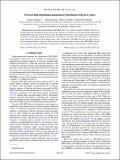| dc.contributor.author | Bunandar, Darius | |
| dc.contributor.author | Zhang, Zheshen | |
| dc.contributor.author | Shapiro, Jeffrey H. | |
| dc.contributor.author | Englund, Dirk Robert | |
| dc.date.accessioned | 2015-03-03T19:29:15Z | |
| dc.date.available | 2015-03-03T19:29:15Z | |
| dc.date.issued | 2015-02 | |
| dc.date.submitted | 2014-11 | |
| dc.identifier.issn | 1050-2947 | |
| dc.identifier.issn | 1094-1622 | |
| dc.identifier.uri | http://hdl.handle.net/1721.1/95763 | |
| dc.description.abstract | High-dimensional quantum key distribution (HD-QKD) allows two parties to generate multiple secure bits of information per detected photon. In this work, we show that decoy-state protocols can be practically implemented for HD-QKD using only one or two decoy states. HD-QKD with two decoy states, under realistic experimental constraints, can generate multiple secure bits per coincidence at distances over 200 km and at rates similar to those achieved by a protocol with infinite decoy states. Furthermore, HD-QKD with only one decoy state is practical at short distances, where it is almost as secure as a protocol with two decoy states. HD-QKD with only one or two decoy states can therefore be implemented to optimize the rate of secure quantum communications. | en_US |
| dc.description.sponsorship | United States. Defense Advanced Research Projects Agency. Quiness Program (United States. Army Research Office. Award W31P4Q-12-1-0019) | en_US |
| dc.description.sponsorship | MIT Bruno Rossi Graduate Fellowship in Astrophysics | en_US |
| dc.publisher | American Physical Society | en_US |
| dc.relation.isversionof | http://dx.doi.org/10.1103/PhysRevA.91.022336 | en_US |
| dc.rights | Article is made available in accordance with the publisher's policy and may be subject to US copyright law. Please refer to the publisher's site for terms of use. | en_US |
| dc.source | American Physical Society | en_US |
| dc.title | Practical high-dimensional quantum key distribution with decoy states | en_US |
| dc.type | Article | en_US |
| dc.identifier.citation | Bunandar, Darius, Zheshen Zhang, Jeffrey H. Shapiro, and Dirk R. Englund. “Practical High-Dimensional Quantum Key Distribution with Decoy States.” Phys. Rev. A 91, no. 2 (February 2015). © 2015 American Physical Society | en_US |
| dc.contributor.department | Massachusetts Institute of Technology. Department of Electrical Engineering and Computer Science | en_US |
| dc.contributor.department | Massachusetts Institute of Technology. Department of Physics | en_US |
| dc.contributor.department | Massachusetts Institute of Technology. Research Laboratory of Electronics | en_US |
| dc.contributor.mitauthor | Bunandar, Darius | en_US |
| dc.contributor.mitauthor | Zhang, Zheshen | en_US |
| dc.contributor.mitauthor | Shapiro, Jeffrey H. | en_US |
| dc.contributor.mitauthor | Englund, Dirk Robert | en_US |
| dc.relation.journal | Physical Review A | en_US |
| dc.eprint.version | Final published version | en_US |
| dc.type.uri | http://purl.org/eprint/type/JournalArticle | en_US |
| eprint.status | http://purl.org/eprint/status/PeerReviewed | en_US |
| dc.date.updated | 2015-02-27T23:00:10Z | |
| dc.language.rfc3066 | en | |
| dc.rights.holder | American Physical Society | |
| dspace.orderedauthors | Bunandar, Darius; Zhang, Zheshen; Shapiro, Jeffrey H.; Englund, Dirk R. | en_US |
| dc.identifier.orcid | https://orcid.org/0000-0002-6094-5861 | |
| dc.identifier.orcid | https://orcid.org/0000-0002-8668-8162 | |
| dc.identifier.orcid | https://orcid.org/0000-0002-8218-5656 | |
| mit.license | PUBLISHER_POLICY | en_US |
| mit.metadata.status | Complete | |
